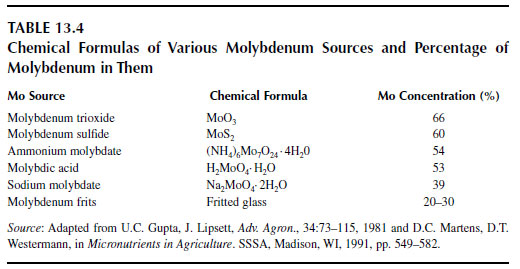Methods of Application
Soil Applications
Molybdenum fertilizers can be incorporated into the soil by banding or by broadcast applications.
Soluble sources of molybdenum such as sodium molybdate and ammonium molybdate may be
sprayed onto the soil surface before tilling to obtain a more uniform coverage, but this practice is
seldom used
(89). Because the molybdenum requirement of plants is low, the quantities of molybdenum
fertilizers needed for crop growth are less than for most other nutrients. Rates of 50 to 100 g
Mo ha
-1 are generally required for soil treatments of agronomic crops, but as much as 400 g Mo
ha
-1 may be needed for vegetable crops such as cauliflower
(12). The uniform application of such
small quantities of molybdenum is often achieved by combining molybdenum with phosphorus fertilizers
or in mixed, complete (N-P-K) fertilizers, to increase the volume of applied material
(89).
Foliar Fertilization
Sodium molybdate and ammonium molybdate are the most commonly used molybdenum sources
for foliar fertilization because of their high solubility in water. Foliar applications of molybdenum
are most effective if applied at early stages of plant development, and generally a 0.025 to 0.1%
solution of sodium or ammonium molybdate (~200 g Mo ha
-1), is recommended
(85). Wetting
agents may also be required in the spray solution to ensure adequate coverage on the foliage of
crops such as onion and cauliflower
(12). Foliar applications of molybdenum are often more
effective than soil applications, particularly for acid soils
(9) or under dry conditions
(115).
Seed Treatment
Seed pelleting, or coating, is the most common method for supplying molybdenum to crops
(89)
and is an effective means of preventing deficiency in crops grown on soils having low concentration
of available molybdenum
(9). This method ensures a more uniform application in the field, and
the amounts of molybdenum that can be coated onto seeds are sufficient to provide adequate molybdenum
for plant growth
(89). Sparingly soluble sources of molybdenum, such as molybdenum trioxide,
are most often used to treat seeds of leguminous crops because soluble molybdenum sources
can decrease the effectiveness of applied bacteria inoculum
(85). Recommended rates for seed treatment
are 7 to 100 g Mo ha
-1 (9,85), and higher rates (>117 g Mo ha
-1) have been found to cause
toxic effects in plants such as cauliflower
(116).





